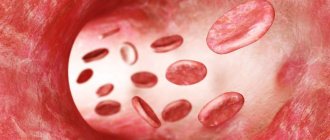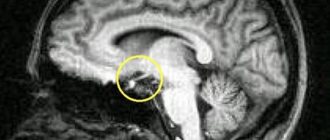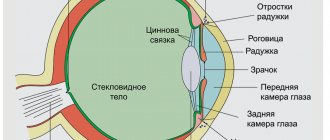general characteristics
ACTH is a hormone secreted by the anterior pituitary gland under the influence of hypothalamic factors. It is a peptide consisting of 39 amino acid residues. Regulates the production of steroid hormones in the adrenal cortex. The secretion of ACTH outpaces the increase in cortisol levels in the blood. The content of ACTH in the blood changes throughout the day. The maximum concentration is at 6-8 o'clock in the morning, the minimum is about 22 o'clock. With a sharp change in time zones, the daily rhythm of ACTH secretion normalizes within 7 to 10 days. Stress is a strong stimulator of hormone release. ACTH levels are also affected by: the phase of the menstrual cycle, pregnancy, emotional state, pain, fever, physical activity, surgical interventions, etc. The half-life in the blood is 3-8 minutes. In pregnant women, there is an increase in ACTH concentration.
References
- Clinical guidelines for diagnosis and treatment and preventive measures for congenital dysfunction of the adrenal cortex in adult patients, 2021. - 72 p.
- Encyclopedia of clinical laboratory tests / ed. WELL. Titsa. - M.: Labinform, 1997. - P. 4-7.
- Histology (introduction to pathology) / ed. E.G. Ulumbekova, Yu.A. Chelysheva. - M.: GEOTAR-Media, 1997. - P. 444-445.
- Kirilyuk, M.L. Itsenko-Cushing's disease. Modern approaches to diagnosis and treatment (clinical lecture). Endocrinology: News. Opinions. Education, 2014. - No. 1(5).
- Kumar, V., Abbas, A., Fausto, N. et al. Robbins and Cotran Pathologic Basis of Disease, 2014. - 1464 p.
CASE DESCRIPTION
Patient P., 36 years old, was admitted to the Federal State Budgetary Institution Endocrinology Center in November 2021 with complaints of increased blood pressure (BP) up to a maximum of 210/140 mmHg, pain in the chest and intercostal spaces during physical activity, swelling and numbness of the arms and legs, weight gain, burgundy stretch marks in the armpits, on the abdomen and thighs, “bruises” on the skin, prolonged wound healing, changes in appearance (rounding and redness of the face), muscle weakness, shortness of breath during exercise, fatigue, weakness, absent-mindedness , headache.
From the anamnesis it is known that in May 2015, at the age of 35 years, after minor physical activity, a compression fracture occurred in the thoracic spine at the Th5-Th6 level (according to MRI), pathological fractures of the ribs on both sides. In June 2015, when performing densitometry of the proximal femur, the Z-criterion was -0.3 SD, the lumbar spine, the Z-criterion was -1.3 SD. In October 2015, an examination revealed: diabetes, glycemia at the onset of 17 mmol/l without any clinical symptoms, regarded as type 1 diabetes, insulin therapy was prescribed; negative overnight suppression test (NST) with 1 mg of dexamethasone (blood cortisol 556 nmol/l) with a normal 24-hour urine test for free cortisol - 157.2 mcg/day (normal 4.3–176) and the absence of organic changes in the adrenal glands on CT scan with intravenous contrast; the level of methylated catecholamines in daily urine is normal. In March 2015, low testosterone levels were determined. However, despite the extensive clinical picture of hypercortisolism (striae, “bruises” on the skin, rounding and redness of the face, prolonged wound healing, muscle weakness, fractures of the vertebrae and ribs, diabetes, hypogonadism) and the absence of cortisol suppression against the background of NPT with 1 mg of dexamethasone, diagnostic and no therapeutic measures were carried out throughout the year (until April 2021).
In April 2021: blood cortisol – 1511.8 nmol/l (normal 260–720), ACTH – 38.4 mcg/l (normal 0–50), 25(OH)D – 12.5 ng/ml ( the norm is more than 30); MRI of the pituitary gland: no pathological changes in the pituitary gland were detected.
Corticotropin releasing hormone test
In rare cases, ACTH can be produced not only by the pituitary gland, but also by a malignant tumor in any organ. Tests show high levels of ACTH and cortisol. To diagnose the pathology, a test with corticotropin-releasing hormone is prescribed. After it, the ACTH level either increases (indicating Itsenko-Cushing's disease) or remains at the same level (ectopic production syndrome).
To carry out the test, venous blood is taken in the morning on an empty stomach and ACTH is measured. Then 100 mcg of corticotropin-releasing hormone is injected into a vein and blood is drawn after 30, 45 minutes and 1 hour, determining the ACTH level for each time.
DISCUSSION
This clinical observation primarily dictates the need to draw the attention of doctors to late diagnosis of the disease in this patient, even with a detailed clinical picture of hypercortisolism (burgundy stretch marks, “bruises” on the skin, rounding and redness of the face against the background of weight gain, prolonged wound healing, muscle weakness , vertebral fractures, diabetes mellitus, low testosterone) and negative NPT with 1 mg dexamethasone, which delayed diagnosis by 6–12 months and could lead to the development of severe disabling complications.
In addition, the presented case of ACTH-ectopic syndrome demonstrates the difficulties of diagnosing this pathology, which lie not so much in the diagnosis of ACTH-ectopic syndrome itself, but in searching for a focus of ectopic ACTH secretion. Unfortunately, the small size of the primary lesion and the absence or non-specificity of the clinical picture specifically from the ACTH-ectopic focus often do not allow detection of the tumor in the early stages, and modern methods of topical diagnosis do not always have sufficient sensitivity.
In our case, the severity of the patient’s condition, due to the presence of a detailed clinical picture of hypercortisolism, in the absence of a source of ACTH ectopia, despite a thorough diagnostic search, incl. Positron emission tomography with 18F-fluorodeoxyglucose was the basis for laparoscopic bilateral adrenalectomy. According to the literature, such treatment tactics have to be chosen in 13% of patients with ACTH-ectopic syndrome [9–10].
The bilateral hyperplasia of the adrenal medulla revealed in our clinical example and the results of an immunohistochemical study (about 30% of the cells of the adrenal medulla express ACTH) with a high degree of probability allow us to consider it as a possible focus of ACTH ectopia with corresponding diffuse micronodular hyperplasia of the adrenal cortex, mainly due to the beam zone. According to the literature [9, 11, 12], pheochromocytomas actually account for at least 2.3–5.6% of all cases of ACTH ectopia. However, in this patient, pheochromocytoma was excluded preoperatively on the basis of normal levels of methylated catecholamines in 24-hour urine and the absence of foci of pathological accumulation of 18F-fluorodeoxyglucose on positron emission tomography. The results obtained suggest that hyperplasia of the adrenal medulla was only a precursor to pheochromocytoma, in our case, bilateral. In the literature, we were able to find a description of a similar case of ACTH ectopia in only one case [12]. The revealed diffuse micronodular hyperplasia of the adrenal cortex does not contradict the results of a morphological study of postoperative material presented by other authors [13].
Since one of the laboratory criteria for the effectiveness of treatment of ACTH-ectopic syndrome is a decrease in ACTH levels, elevated ACTH levels in patient P. that persist in the morning and evening (while taking 45 mg of hydrocortisone), on the one hand, may indicate a persistence of the source of ACTH-ectopic syndrome , which requires further dynamic observation and continuation of topical diagnostics to search for the primary focus, on the other hand, they can also be considered as a variant of the norm in the response of a healthy pituitary gland to bilateral adrenalectomy.
4. Risks of analysis and what can interfere with the test?
Risks of ACTH testing
If you take a blood test for ACTH, then possible risks may only be associated with taking blood from a vein. In particular, the appearance of bruises at the site of blood sampling and inflammation of the vein (phlebitis). Warm compresses several times a day will relieve phlebitis. If you are taking blood thinning medications, you may bleed at the puncture site.
What can interfere with the test?
Reasons why you may not be able to take a corticotropin test include:
- Taking corticosteroid drugs, estrogens, spironolactone. Also, the test results can be affected by amphetamines and insulin, after taking which the level of cortisol is increased.
- Alcohol or drug intoxication.
- Pregnancy or menstruation in women.
- Physical or emotional stress.
The role of ACTH in a woman’s body
Functions of ACTH
- Stimulates the formation of protein and nucleic acids in adrenal cells during prolonged exposure to ACTH. This leads to the growth of the adrenal glands and the proliferation of their cortex. Since the adrenal glands produce a number of important hormones (cortisol, sex hormones progesterone, estrogens, testosterone), their proliferation leads to an increase in the concentration of these substances.
- Directly increases cortisol synthesis with short-term exposure to ACTH. The main role of cortisol is to mobilize the body's resources in a stressful situation. Cortisol provides:
- a rush of blood to the muscles, which allows you to use the “fight or flight” reflex during stress;
- increasing blood glucose levels, which is necessary to improve muscle function;
- has an antiallergic effect;
- has analgesic, anti-inflammatory and anti-stress effects.
Negative properties of cortisol
- immunosuppression – reduces the production of lymphocytes and antibodies;
- decreased muscle mass due to increased protein breakdown;
- slow digestion, decreased intestinal motility;
- deterioration of cognitive abilities - thinking, remembering, understanding, learning, motivation.
- Affects the synthesis of mineralocorticoids - hormones that regulate mineral metabolism (aldosterone, deoxycorticosterone). Aldosterone promotes inflammation and affects kidney function by increasing urinary excretion of potassium and decreasing urinary excretion of sodium. These minerals are responsible for the ability of tissues to retain water, increase the amount of circulating blood, and increase blood pressure. Deoxycorticosterone has similar properties, but less activity.
- Activates androgen precursors – dihydroepiandrostenedione and androstendinone. This leads to an increase in the level of male sex hormones and can be manifested by hair growth on the face and body, acne, ovarian dysfunction and menstrual irregularities.
- Increases the synthesis of cholesterol necessary for the construction of cell walls, nerves, the formation of vitamin D, and the protection of red blood cells from harmful influences.
- Has a melanocyte-stimulating effect. Forces melanocytes to produce more melanin pigment, which determines the color of skin, hair, and iris.
- Affects brain cells. Affects memory, motivation, learning processes. ACTH deficiency causes indifference to the environment, depression, memory impairment, and psychosis.
- Interacts with other peptide hormones – they mutually increase each other’s influence on the body:
- prolactin – is responsible for the growth of the mammary glands, the formation of milk in them, the inhibition of the menstrual cycle, and also reduces the level of estrogen; influences the development of secondary reproductive organs;
- somatotropin - if in excess, children can experience active body growth, and in adults it helps remove fat from fat depots (subcutaneous fat) and their oxidation;
- vasopressin - affects vascular tone and blood pressure, increasing the volume of blood in the vessels.
Regulation of ACTH synthesis
Adrenocorticotropic hormone is produced by a gland at the base of the brain - the pituitary gland, but its synthesis is influenced by the hypothalamus and adrenal glands. These three glands make up the hypothalamic-pituitary-adrenal system, which is responsible for producing and maintaining the required level of hormones.
Serum ACTH levels are regulated through feedback. Schematically, this mechanism looks like this:
- The hypothalamus analyzes the level of adrenal hormones - corticosteroids.
- The hypothalamus enhances the work of the pituitary gland and the synthesis of ACTH with the help of the hormone corticoliberin.
- ACTH acts on receptors located on the membrane of adrenal cortex cells, activating the synthesis of corticosteroids.
- High levels of corticosteroid hormones are sensed by the hypothalamus and suppress the production of ACTH in the pituitary gland.
Failure of this system leads to hormonal imbalance, which is expressed in various diseases.
Clinic Family Doctor on Usacheva
The Family Doctor clinic on Usacheva began operating in 2009 and currently provides medical care to adults and children in most medical specialties. Appointments are provided by: therapists, gastroenterologists, cardiologists, coloproctologists, surgeons (general surgery, mammology, phlebology, oncology), orthopedic traumatologists, obstetricians-gynecologists, neurologists, rehabilitation and recovery treatment (physiotherapy, medical massage, manual therapy, reflexology), urologists , dentistry (appointment, treatment, surgery, implantology), orthodontists, otorhinolaryngologists, ophthalmologists, endocrinologists, dermatovenerologists, cosmetologists, trichologists, allergists-immunologists, psychotherapists and psychiatrists, radiologists.
Patients are provided with a wide range of clinical and laboratory and instrumental diagnostics, X-ray examinations, including in dentistry (digital orthopantomography (OPTG) and radiovisiography), CBCT (cone beam computed tomography); expert ultrasound diagnostics, functional diagnostics: studies of the vessels of the head and neck, upper and lower extremities, ECHO-cardiography (ECHO-CG), electrocardiography (ECG), comprehensive study of the functions of the respiratory system, 24-hour Holter ECG monitoring, 24-hour blood pressure monitoring (ABPM) ), bicycle ergometry, gastroscopy (EGD), colonoscopy (FGDS) under anesthesia, cystoscopy, dental treatment of any complexity, including during sleep. The clinic on Usacheva provides dispensary and preventive observation within the framework of specially developed medical programs: management of pregnancy at all stages, CheckUp programs, personalized individual observation.
In the building, medical documents, extracts, certificates of temporary incapacity for work and certificates are drawn up for Usachev.
3.How to prepare and how is the analysis carried out?
How to prepare for an ACTH test?
You should not eat, drink, stress, or exercise for 10 to 12 hours before your blood draw.
If the doctor wants to measure the peak level of corticotropin in the blood, then the tests will have to be taken in the morning; if the doctor wants to find out the lowest level, then in the evening.
How is ACTH analysis performed?
An ACTH test is performed after taking blood from a vein. Blood sampling from a vein is carried out according to a standard procedure.
About our clinic Chistye Prudy metro station Medintercom page!
ACTH is low
Insufficient production of the hormone is associated with the following processes:
- secondary hypocortisolism. If the functioning of the pituitary gland is disrupted (insufficient production of ACTH), atrophy of the adrenal cortex occurs (lack of cortisol synthesis). Functional failure of other glands of the endocrine system may also occur;
- Itsenko-Cushing syndrome. The level of adrenocorticotropic hormone falls in the presence of a malignant tumor in the adrenal glands. It differs from Cushing's disease in that there is excessive production of cortisol and, as a result, a reduction in the production of ACTH by the pituitary gland;
- benign formations in the adrenal glands. The tumors in this case perform the function of the organ and produce additional cortisol, which reduces ACTH levels;
- taking medications from the glucocorticoid group, cryptoheptadine.
RELEVANCE
The prevalence of endogenous hypercortisolism is about 5–6 cases per 1 million people, with 1–2 new cases per 1 million diagnosed annually [1].
The share of ACTH-dependent hypercortisolism in the overall structure is about 80%. Among this cohort of patients, in 70–75%, the cause of hypersecretion of adrenocorticotropic hormone (ACTH) is corticotropinoma, another approximately 10% are diagnosed with corticotroph hyperplasia, and in the remaining 15–20%, neuroendocrine tumors of various localizations producing ACTH and/or corticoliberin [1–4 ]. A patient with oat cell lung cancer and the clinical picture of hypercortisolism was first described in 1928 by W. Brown [5]. In 1960, peptides were isolated from a lung tumor with adrenocorticotropic activity, and in 1969 G. Liddle et al. proved the pathogenetic connection between hypercortisolism and the functional activity of certain types of tumors, which made it possible to identify a new disease called “ACTH-ectopic syndrome” [6].
According to epidemiological data, in 5–10% of cases, the source of ectopic ACTH production is tumors of extrapituitary localization: bronchial carcinoid tumors (36–46%), oat cell lung cancer (18–20%), pheochromocytoma (9–23%), medullary thyroid cancer glands (3–7%), tumors of the pancreas, thymus and parotid glands, ovaries, uterus, prostate, colon, stomach, esophagus and other organs [3, 7]. With ACTH-ectopic syndrome, the development of clinical manifestations, as a rule, occurs faster than with corticotropinoma, which determines the uniqueness of the clinical picture [4]. Difficulties in identifying the primary focus of ACTH hypersecretion may be due to its small size, the absence or nonspecificity of the clinical picture from the primary focus, and early metastasis in the case of malignant tumors. In addition, the most common manifestations of hypercortisolism (such as arterial hypertension, myopathy, carbohydrate metabolism disorders, including diabetes mellitus (DM), electrolyte disorders and increased protein catabolism, contributing to the development of myopathy and low-traumatic fractures, hypogonadism, etc. .) can sometimes be considered as independent nosological forms, which creates certain difficulties at the stages of early diagnosis and timely treatment of ACTH-ectopic syndrome. The given clinical case is proof of this.
The role of ACTH in a woman’s body
Functions of ACTH
- Stimulates the formation of protein and nucleic acids in adrenal cells during prolonged exposure to ACTH. This leads to the growth of the adrenal glands and the proliferation of their cortex. Since the adrenal glands produce a number of important hormones (cortisol, sex hormones progesterone, estrogens, testosterone), their proliferation leads to an increase in the concentration of these substances.
- Directly increases cortisol synthesis with short-term exposure to ACTH. The main role of cortisol is to mobilize the body's resources in a stressful situation. Cortisol provides:
- a rush of blood to the muscles, which allows you to use the “fight or flight” reflex during stress;
- increasing blood glucose levels, which is necessary to improve muscle function;
- has an antiallergic effect;
- has analgesic, anti-inflammatory and anti-stress effects.
Negative properties of cortisol
- immunosuppression – reduces the production of lymphocytes and antibodies;
- decreased muscle mass due to increased protein breakdown;
- slow digestion, decreased intestinal motility;
- deterioration of cognitive abilities - thinking, remembering, understanding, learning, motivation.
- Affects the synthesis of mineralocorticoids - hormones that regulate mineral metabolism (aldosterone, deoxycorticosterone). Aldosterone promotes inflammation and affects kidney function by increasing urinary excretion of potassium and decreasing urinary excretion of sodium. These minerals are responsible for the ability of tissues to retain water, increase the amount of circulating blood, and increase blood pressure. Deoxycorticosterone has similar properties, but less activity.
- Activates androgen precursors – dihydroepiandrostenedione and androstendinone. This leads to an increase in the level of male sex hormones and can be manifested by hair growth on the face and body, acne, ovarian dysfunction and menstrual irregularities.
- Increases the synthesis of cholesterol necessary for the construction of cell walls, nerves, the formation of vitamin D, and the protection of red blood cells from harmful influences.
- Has a melanocyte-stimulating effect. Forces melanocytes to produce more melanin pigment, which determines the color of skin, hair, and iris.
- Affects brain cells. Affects memory, motivation, learning processes. ACTH deficiency causes indifference to the environment, depression, memory impairment, and psychosis.
- Interacts with other peptide hormones – they mutually increase each other’s influence on the body:
- prolactin – is responsible for the growth of the mammary glands, the formation of milk in them, the inhibition of the menstrual cycle, and also reduces the level of estrogen; influences the development of secondary reproductive organs;
- somatotropin - if in excess, children can experience active body growth, and in adults it helps remove fat from fat depots (subcutaneous fat) and their oxidation;
- vasopressin - affects vascular tone and blood pressure, increasing the volume of blood in the vessels.
Regulation of ACTH synthesis
feedback
- The hypothalamus analyzes the level of adrenal hormones - corticosteroids.
- The hypothalamus enhances the work of the pituitary gland and the synthesis of ACTH with the help of the hormone corticoliberin.
- ACTH acts on receptors located on the membrane of adrenal cortex cells, activating the synthesis of corticosteroids.
- High levels of corticosteroid hormones are sensed by the hypothalamus and suppress the production of ACTH in the pituitary gland.









